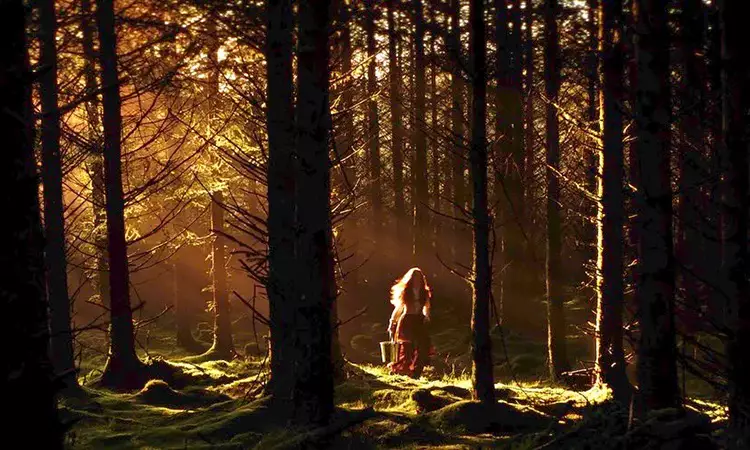An Taibhse (The Ghost), a cinematic endeavor penned and directed by John Farrelly, unfolds a multifaceted narrative that blends the supernatural with the poignant tribulations of coming-of-age. The story opens with a chilling exchange between young Máire Finegan (played by Livvy Hill) and her father Éamon (Tom Kerrisk) during a nocturnal coach ride, illuminated by dim candlelight. This harrowing juxtaposition of darkness and light serves as a metaphor for the dualities present in the film: the lingering shadows of grief and the flickering hope of resilience. The opening line, suffused with dread, not only sets a tone of uncertainty but foreshadows a descent into both psychological and supernatural realms.
The character of Alexander serves as a lynchpin in Máire’s psychological landscape. Her father’s adamant dismissal of this seemingly phantasmal figure points to the layers of denial that often accompany grief. Éamon’s insistence that Alexander “is not real” reflects a protective instinct that veils the deeper anxieties harbored within both characters. As the plot unfolds, it becomes increasingly ambiguous whether Alexander represents a psychological defense mechanism borne from Máire’s unresolved feelings concerning her mother’s death or if he embodies a genuine supernatural presence. This ambiguity not only enriches the narrative but also prompts viewers to interrogate the fine line between reality and the imagination, especially for a child dealing with profound loss.
The themes of isolation and caretaking dominate the film, as father and daughter assume the role of caretakers in a sprawling, dilapidated mansion. The setting, characterized by its ghostly ambiance and foreboding architecture, acts almost as a character itself. Similar to the ominous Overlook Hotel in Stanley Kubrick’s The Shining, the mansion encases historical secrets and emotional burdens, further intensifying the atmospheric dread that envelops the narrative. As the snow piles up outside, the couple becomes trapped not only by physical barriers but by the emotional scars that the loss of a beloved figure has wrought upon them.
Farrelly’s choice to depict Éamon’s gradual unraveling through alcohol is both poignant and unsettling. As he sinks deeper into inebriation, Éamon transforms from a frail father into a menacing figure, wielding the very axe of domestic horror. This shift elucidates the often ignored discourse surrounding toxic masculinity and substance abuse, suggesting that the true horror lies not just within the supernatural, but also in the very real consequences of a parent’s emotional and physical neglect.
Meanwhile, the presence of the spectral Alexander becomes intertwined with Máire’s rapidly changing domestic landscape. As her father retreats further into addiction, Máire is thrust into the role of caregiver—an inversion of the traditional parent-child dynamic. The film’s emotional gravity is amplified as we watch her perform Herculean tasks amid increasing chaos, all while grappling with shadowy apparitions that emerge from the recesses of her mind. This duality of care and fear heightens the tension and engages the audience with a heartbreaking exploration of childhood innocence tarnished by adult crises.
An Taibhse cleverly employs symbols to amplify its thematic richness. The appearances of the crimson book and the Punch puppet emphasize the often unsettling intersection of childhood and adult realities. The book, laden with forbidden knowledge, hints at the sexual awakening accompanying Máire’s journey into womanhood—a crucial aspect as it parallels her struggle against the encroaching shadows of her father’s instability. These symbols invite an interpretation that transcends mere horror; they echo the chaotic amalgamation of trauma, innocence, and burgeoning self-awareness.
As the narrative hurtles toward its climax, the montage of imagined horrors and visceral truths culminates in Máire’s emotional reckoning. Her painful admission that she wishes Alexander were real encapsulates her yearning for solace, underscoring the film’s complex relationship with fantasy as a form of escapism. By grappling with her demands, both external and internal, Máire embodies the struggle of an adolescent confronted with the trauma of reality.
Ultimately, An Taibhse transcends conventional horror tropes to present a haunting study of familial dynamics and the weight of trauma. Farrelly’s emphasis on editing and lighting over special effects creates an atmosphere steeped in unease—where the true horror stems not from supernatural entities, but from the psyche of a girl caught in a web of denial, chaos, and burgeoning awareness. In the tension that exists between the spectral Alexander, the grotesque Punch puppet, and the flawed father, the film presents a narrative rife with haunting themes of desire and menace, encapsulating the very essence of psychological horror through a unique lens. In this way, An Taibhse serves as both a ghost story and an exploration of the tumultuous journey into adulthood, leaving audiences to ponder the nature of fear as they exit the theatre.

